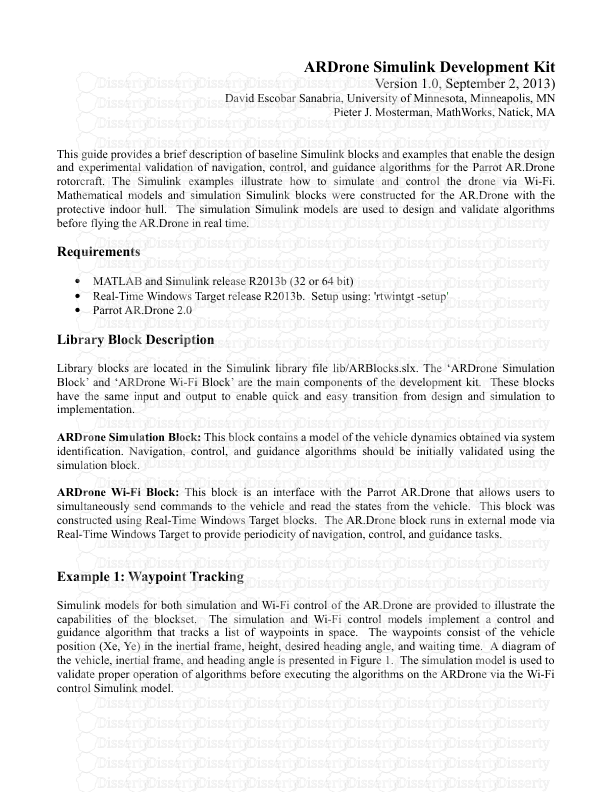ARDrone Simulink Development Kit Version 1.0, September 2, 2013) David Escobar
ARDrone Simulink Development Kit Version 1.0, September 2, 2013) David Escobar Sanabria, University of Minnesota, Minneapolis, MN Pieter J. Mosterman, MathWorks, Natick, MA This guide provides a brief description of baseline Simulink blocks and examples that enable the design and experimental validation of navigation, control, and guidance algorithms for the Parrot AR.Drone rotorcraft. The Simulink examples illustrate how to simulate and control the drone via Wi-Fi. Mathematical models and simulation Simulink blocks were constructed for the AR.Drone with the protective indoor hull. The simulation Simulink models are used to design and validate algorithms before flying the AR.Drone in real time. Requirements • MATLAB and Simulink release R2013b (32 or 64 bit) • Real-Time Windows Target release R2013b. Setup using: 'rtwintgt -setup' • Parrot AR.Drone 2.0 Library Block Description Library blocks are located in the Simulink library file lib/ARBlocks.slx. The ‘ARDrone Simulation Block’ and ‘ARDrone Wi-Fi Block’ are the main components of the development kit. These blocks have the same input and output to enable quick and easy transition from design and simulation to implementation. ARDrone Simulation Block: This block contains a model of the vehicle dynamics obtained via system identification. Navigation, control, and guidance algorithms should be initially validated using the simulation block. ARDrone Wi-Fi Block: This block is an interface with the Parrot AR.Drone that allows users to simultaneously send commands to the vehicle and read the states from the vehicle. This block was constructed using Real-Time Windows Target blocks. The AR.Drone block runs in external mode via Real-Time Windows Target to provide periodicity of navigation, control, and guidance tasks. Example 1: Waypoint Tracking Simulink models for both simulation and Wi-Fi control of the AR.Drone are provided to illustrate the capabilities of the blockset. The simulation and Wi-Fi control models implement a control and guidance algorithm that tracks a list of waypoints in space. The waypoints consist of the vehicle position (Xe, Ye) in the inertial frame, height, desired heading angle, and waiting time. A diagram of the vehicle, inertial frame, and heading angle is presented in Figure 1. The simulation model is used to validate proper operation of algorithms before executing the algorithms on the ARDrone via the Wi-Fi control Simulink model. Figure 1. Vehicle diagram and frames. Instructions for simulation: 1. Edit the list of waypoints located at lib/getWaypoints() 2. Run the simulation setup file simulation/setupWPTrackingSim.m 3. Run the Simulink model simulation/ARDroneWPTracking.slx Instructions for Wi-Fi control 1. Connect to the ARDrone Wi-Fi network 2. Edit the list of waypoints located at lib/getWaypoints() 3. Run the setup script wifiControl/setupWPTracking.m 4. Build (ctrl+b) the Simulink model wifiControl/ARDroneWPTracking.slx 5. Make sure inputs fly, enable reference commands, and emergency stop are set to zero 6. Connect to the target and run wifiControl/ARDroneWPTracking.slx 7. Switch input fly to 1 to take off. Switch input enable reference commands to 1 to start sending commands from the Simulink controller. The heading angle is set to zero when input input enable reference commands is set to 1. Example 2: Hovering and Position Control This is a simplified version of the waypoint tracking example, for which the position and heading references are connected to constant blocks. Follow instructions from Example 1. Setup files for simulation and Wi-Fi control are simulation/setupHoverSim.m and wifiControl/setupHover.m, respectively. Simulink models are simulation/ARDroneHover.slx and wifiControl/ARDroneHover.slx, respectively. Example 3: Baseline Simulation The Simulink model simulation/ARDroneBaseSim.slx enables the simulation of the AR.Drone response to input commands. Outputs are the velocities in the body frame, orientation angles, height, battery level, and state of the drone. The inputs are reference commands for roll angle, pitch angle, yaw rate, and vertical velocity. Three manual switches are used to take off, land, enable commands, and turn off motors (emergency landing). Video Streaming The video streaming from the ARDrone can be obtained using ffmpeg, For more information visit: http://ffmpeg.org/ The following command displays the video streaming from the front camera of the ARDrone: ffplay -f h264 -i http://192.168.1.1:5555 The following command records the video streaming from the front camera of the ARDrone to Portable Network Graphics (PNG) images. ffmpeg -f h264 -i http://192.168.1.1:5555 -f image2 -vf fps=fps=10 out%d.png uploads/Geographie/ guide - 2023-05-31T024257.441.pdf
Documents similaires










-
49
-
0
-
0
Licence et utilisation
Gratuit pour un usage personnel Attribution requise- Détails
- Publié le Jan 20, 2021
- Catégorie Geography / Geogra...
- Langue French
- Taille du fichier 0.1243MB


